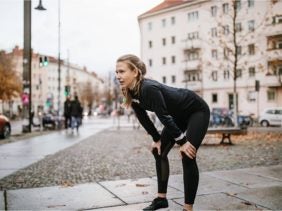7 Ways You Can Walk Your Way to Weight Loss, Say Experts
 ©Westen61
©Westen61
Think walking is only about getting from point A to B? Think again! Walking has an unfair reputation for being boring. It’s often overlooked when it comes to weight loss activities. But not only are walks easy to incorporate into everyday life; with the right tips, you can turn a stroll into a super efficient workout! Walking for weight loss can work when paired with a conscious, balanced diet. Supplemented with our Shape Shake 2.0, you’ll already be on the way to your feel-good weight*. Read on as we reveal the best tips on how to lose weight while walking and what science has to say about it.
-
Wait for the Right Time of Day
Some people like to get moving first thing in the morning, while others find it harder to get going. If you’re not a morning person, don’t stress. According to a scientific study by the Netherlands Cardiovascular Research Initiative, the best time to go for a walk is in the afternoon anyway. Test subjects who were only active in the second half of the day lost more weight and had a more stable blood sugar level over a period of twelve weeks than those who were only active in the morning. The reason: researchers assume that blood sugar levels only rise later in the day, once you’ve eaten more food. High blood sugar levels increase fat storage. If you schedule your walking for weight loss in the afternoon – exactly when your blood sugar level peaks – you can quickly bring it back down with exercise, before your body has a chance to convert the sugar into fat.
-
Increase Your Walking Speed
The number of calories you burn while walking for weight loss depends, among other things, on how much you weigh and how fast you’re going. According to a study by the Harvard Medical School, someone who weighs 70 kilos can burn around 186 calories with a 30-minute walk at a moderate speed of 6.4 kilometers per hour. Someone weighing 56 kilos burns around 150 calories, and someone who weighs 84 kilos burns about 222 calories.
Since we normally walk at an average speed of about 4-6 km/h, you might try going a bit faster in order to boost the fat burning process! A nice goal speed might be an average of about 7 km/h.
-
Work In Some Bodyweight Exercises
If you upgrade your walk with a few bodyweight exercises while you’re out, you’ll benefit twice over. Each of those mini-workouts will help you burn even more calories. Plus, you’ll also benefit from the afterburn effect. That means after your workout, you’ll still be burning extra calories. Yep, even when you’re back at your desk again. Couldn’t get better than that!
Need a few bodyweight exercises that are easy to include in your walking for weight loss? Try lunges, squats in all their variations, or burpees.
-
Walk Together
As with everything meant to have a long-term effect: consistency is key! The World Health Organization (WHO) recommends that adults incorporate moderate activity into their daily routine for 150 to 300 minutes a week to support cardiovascular strength. Win-win, then.
In order to keep your motivation high and fight against your inner slacker, get some support, either in the form of friends who can join you on a regular basis (and if you’ve made a date, it’s harder to cancel), or with the help of your favorite playlist or exciting podcasts and audiobooks. Anything that makes you feel good and motivates you to keep going is great!
-
Make the Most of Hills and Stairs
You can burn about 30 percent more calories by incorporating small inclines into your walk instead of just walking on level ground. Changing your walking surface can also help boost fat burning. After all, walking on grass, sand, or gravel takes more effort than a paved sidewalk. Climbing stairs bumps your calorie consumption even further: just ten minutes of stair climbing a day can melt away up to 90 extra calories, depending on your weight, and that can make a big difference for your glutes and quads.
-
Turn Off the Trackers
Yes, you read that right. Fitness apps and smart watches make it easier than ever for people to count every step they take these days. But when it comes to walks, this can actually have a negative impact on your results. According to this study, subjects who were out and about without trackers were able to lose an average of around 2.2 kilos more weight than those who had their steps counted. One possible explanation is that some fitness tracker owners focus purely on their steps instead of looking at the big picture. After all, healthy and sustainable weight loss depends in large part on your diet and calorie balance, no matter how much walking you do.
So don’t worry about pacing around your living room last thing at night, or taking an extra lap around the block at the end of your walk, just to hit a certain number of steps. Instead, think of every extra step you take as a bonus that supports your body on your way to your desired weight.
-
Integrate Intervals
Not only does brisk walking boost fat burning, but so does varying your speed. Incorporate some kind of interval training when you walk, alternating very fast walking with slower steps, such as increasing your speed for one to two minutes every five minutes and then slowing down a bit. According to an Ohio State University study, this can result in 20 percent more calories burned than walking at a steady pace.
More healthy living tips from foodspring:
- Healthy Weight Loss: Reach Your Goals Without Making Sacrifices
- Weight Loss Workout Plan: What you need to know
- 8 Ways to Lose Weight on a Vegan Diet
- Is yo-yo dieting worth the effort? 6 ways to keep the weight off after all your hard work
- How to lose weight and keep it off: Expectations vs reality
* Replacing two of your main daily meals with Shape Shake 2.0 as part of a low-calorie diet contributes to weight loss. Shape Shake 2.0 can only fulfill this purpose if it is used as part of a balanced low-calorie diet, which must include other foods. You must also make sure you are getting enough hydration. To maintain a healthy lifestyle, make sure you eat a balanced and varied diet.
Sources for this article
We at foodspring use only high-quality sources, including peer-reviewed studies, to support the facts within our articles. Read our editorial policy to learn more about how we fact-check and keep our content accurate, reliable, and trustworthy.





























